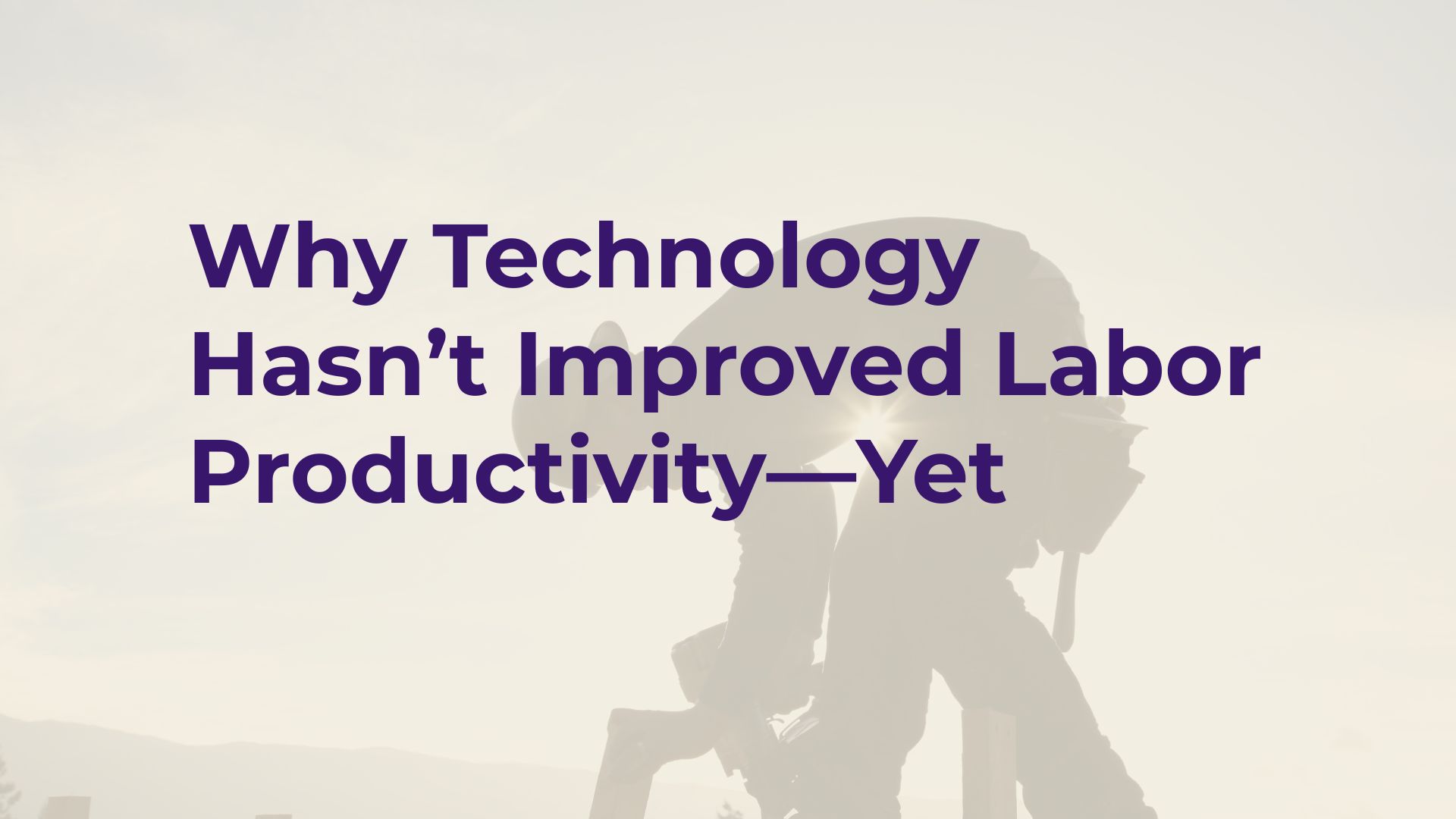
Introduction
Construction is physical. No software can make someone more productive at installing drywall or pouring concrete — that’s the job of hardware tools. But that doesn’t mean software can’t transform construction productivity. In fact, it can play a critical role in improving labor productivity across your organization.
Think of a delivery driver. Software can’t make someone drive faster, but it can help them complete deliveries more efficiently — by planning routes, avoiding delays, and keeping everything organized. It doesn’t improve the driving itself; it makes the function of delivery more productive.
Construction technology needs to take a similar approach. It can’t install drywall or dig trenches. But it can create the conditions for better execution — helping crews show up at the right place, do the right work, and move efficiently through the day. It’s about rethinking how labor is organized, supported, and improved — not through pressure, but through smarter coordination and continuous learning.
Match Crews to the Right Work
One of the most overlooked opportunities to improve productivity is also one of the most obvious: make sure the people doing the work are the right people for the job. Yet in practice, crew assignments are often made based on who’s available — not necessarily who’s best suited. It’s understandable. Projects move fast, crews shift daily, and there’s rarely time to think deeply about matching individual skills to specific tasks. But that gap comes at a cost.
When a task is assigned to someone who isn’t fully qualified — whether due to lack of experience, certification, or familiarity with the work — the impact goes well beyond that individual. Progress slows, mistakes are more likely, and quality becomes a risk. Even small errors can trigger rework, delay dependent tasks, or force supervisors to step in, pulling attention from other parts of the job. One mismatch can ripple through an entire crew’s productivity.
At the same time, overqualification comes with its own hidden cost. Assigning a highly skilled worker to a basic task might seem like a safe move, but it wastes potential. It also means someone else — perhaps a less experienced team member who could have handled the job with a little support — loses a valuable opportunity to learn. Over time, these missed chances add up, limiting the growth of the workforce and reinforcing a reliance on a small group of experienced hands.
That’s why assignment shouldn’t just be tactical. It should be strategic. Each project is a chance to build skill depth across the crew — to create broader pools of capability that can be leveraged across future jobs. Technology can help support this mindset. By tracking crew capabilities over time and identifying where stretch assignments make sense, software can make it easier to balance today’s needs with tomorrow’s workforce readiness.
The goal isn’t perfection — it’s intention. Matching people to the right work means making decisions that support the tactical demands of the current project and the strategic goals of building a stronger workforce over time.
Match Crews That Work Well Together — and Build for the Future
In construction, getting the work done efficiently isn’t just about assigning the right task to the right person — it’s about building the right crew. Some teams just work better together. They communicate more smoothly, anticipate each other’s needs, and solve problems with less friction. These dynamics might not be formalized in any schedule or spreadsheet, but they have a direct impact on productivity, quality, and jobsite flow.
That’s why the first priority should be tactical: match crews that have demonstrated they work well together. Whether through supervisor experience or performance data, these combinations should be leveraged to ensure smooth execution, especially on critical path tasks or high-pressure phases of a job.
But alongside this tactical matching, there’s also a strategic opportunity — one that doesn’t require disrupting what’s already working. On lower-risk jobs or less time-sensitive scopes of work, there’s room to try new combinations. Doing so helps in two ways: it allows crews to build experience working with a broader group of teammates, and it may surface combinations that perform better than the familiar ones. Some of the most productive teams are discovered, not designed — but only if you create space to observe and learn.
Technology can support both goals. It can reinforce what’s already known about which crews perform well together, while also tracking the performance of new combinations over time. This dual approach — tactical matching when it matters most, strategic rotation when the opportunity allows — helps create a workforce that’s not only productive today, but more flexible and resilient tomorrow.
Forecast and Fill Labor Needs Early
Few things disrupt a project more than not having the right people on site when the work is ready to begin. Sometimes it’s a numbers issue — not enough people. More often, though, it’s a matter of timing and fit: the right mix of skills, certifications, and crew availability wasn’t aligned early enough. That’s not just a scheduling problem — it’s a productivity problem.
When labor needs aren’t anticipated far enough in advance, project teams are forced into reactive decisions. Crews get reassigned at the last minute, mismatched skills are shoehorned into available slots, and short-term workarounds take priority over long-term quality. These disruptions aren’t always visible in a schedule, but they show up quickly in the field — in missed deadlines, rework, and stalled progress.
Better forecasting can change that. By analyzing project timelines, historical productivity, and current crew capacity, software can help teams anticipate not just how many people they’ll need, but what skills, certifications, and roles will be required — and when. That visibility gives project leaders time to mobilize the right people and prepare the work environment before anyone steps foot on site.
But labor forecasting doesn’t just help internally. When companies can see farther ahead, so can their partners. Manpower suppliers can plan better deployments. Training organizations like ABC and AGC can align programs with upcoming skill demand, increasing the relevance and readiness of their graduates. This kind of coordination strengthens the entire ecosystem.
The tactical benefit is clear: fewer surprises, smoother mobilization, and more consistent productivity. The strategic benefit is even greater: a more reliable workforce pipeline, tighter coordination with external partners, and a reduced reliance on last-minute fixes that tend to cost more and deliver less.
Adapt Quickly When Things Change
Change is a constant on construction projects. Sometimes it’s internal — a task takes more effort than forecasted, and one project suddenly needs more labor than expected. Sometimes it’s scope-related — a change order adds unplanned work, forcing teams to pull crews away from other jobs. And sometimes it’s external — the jobsite isn’t ready when the crew is, or key materials haven’t arrived, leaving the team with no productive work to do.
No matter the cause, the result is the same: carefully built labor plans start to unravel. Crews end up idle in some places and stretched too thin in others. And the longer it takes to respond, the greater the risk of lost productivity across multiple jobs.
That’s why one of the most valuable tactical tools isn’t the one that helps you build a perfect labor plan — it’s the one that helps you adapt when that plan inevitably changes. With visibility into live schedules, skillsets, and crew availability across projects, software can help teams quickly reassign labor, rebalance workloads, and respond to shifting needs before they cascade into larger disruptions.
The goal isn’t to eliminate change — that’s impossible. The goal is to respond to change with the least disruption and the least loss of crew productivity. That’s what keeps projects — and people — moving forward.
Automate the Crucial Communication That Keeps Everyone Aligned
In construction, not all communication needs to be manual — in fact, some of the most valuable updates are the ones that can happen automatically. When a crew doesn’t know where they’re going, when a supervisor isn’t aware that new people have been assigned to address their growing needs, or when a project planner finds out too late that a task is already behind schedule — productivity takes a hit. And yet, these are exactly the kinds of updates that don’t require meetings or manual check-ins. They just need to happen.
The opportunity lies in automating the routine communications that keep people aligned without requiring extra effort. When a crew is assigned to a jobsite, they should automatically receive details about where they’re going and how long it might take to get there. When a supervisor is given additional crew members to support an expanding workload, that change should be pushed to them right away — not discovered in the middle of a shift. And when a delay is forecasted, or already unfolding, the people responsible for labor planning should know early enough to do something about it.
These kinds of updates are simple, but their impact is real. They reduce confusion, eliminate the lag between change and response, and surface risk before it turns into downtime. Just as importantly, they do it without putting extra burden on the field. Crews don’t need to log more data. Supervisors don’t need to chase down information. The system does the work, and everyone stays better informed.
When communication is embedded into the tools people already use — and when it happens automatically — it stops being a task and starts being an asset. It creates alignment not through more effort, but through smarter systems.
Conclusion
No software tool can make someone faster at hanging drywall or pouring concrete — that’s the role of hardware tools and trade skills. But software can still play a powerful role in improving labor productivity — not by changing the physical work itself, but by improving how that work is supported, coordinated, and executed.
Just as delivery software doesn’t make someone drive faster but helps make the delivery function more productive, construction software can make labor more effective by creating the right conditions: getting the right crews in the right place, keeping projects aligned, and minimizing the friction that slows work down.
And that support can happen on two levels. Tactically, technology can help respond to day-to-day realities — matching crews, adapting to changes, and communicating clearly in real time. Strategically, it can help companies build stronger, more flexible teams over time — by forecasting needs, growing skill capacity, and improving collaboration across the workforce.
Construction software may not speed up the physical task, but it can help make the entire operation more productive — by improving how the work gets done.



